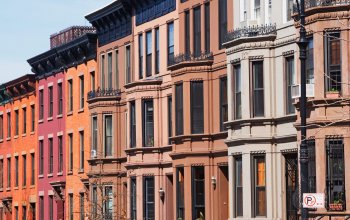
NYC’s land use ballot measure, explained

What to know about Ballot Question No. 5 in this year’s general election
It’s Election Day! In this year’s general election, New Yorkers aren’t just being asked to vote on candidates for various elected positions; they’re also being asked to help amend the municipal charter, the governing document of the entire city of New York.
Turn your ballot over and you’ll find five questions addressing different issues within the charter. Four of these revolve around things like increased oversight of the NYPD, the implementation of ranked choice voting, and the creation of a “rainy day fund” in the city’s budget.
But for Curbed’s purposes, there is one measure related to land use: Ballot question No. 5, which would amend the city’s Uniform Land Use Review Procedure (ULURP). This measure would, in essence, give borough presidents and community boards more time to review project summaries for developments subject to ULURP, and would require that project summaries be posted online.
If you’re confused by what that paragraph means, you’re likely not alone—here, we’ve broken down this particular ballot measure, as well as who’s for and against it, and what it could mean for the city.
Okay, so help me out: What is ULURP and why should I care?
An excellent, and somewhat complicated, question!
All land in the city is zoned for a particular use—residential, commercial, and so on—and for a certain allowable density. (It’s … complicated.) Let’s say a developer or property owner wants to build something on land that they own, but the zoning for the underlying land doesn’t match what they want to build. Or maybe they want to construct a more dense building than the current zoning allows. In order to make those changes happen, the developer or property owner would need the city to agree to rezone the land for their preferred use—and to do that, they must go through the city’s Uniform Land Use Review Procedure, or ULURP.
ULURP is a complex, multi-step process (the Department of City Planning has a chart that lays out the various steps) that requires a buy-in from various local elected officials and community groups. Once a developer or property owner files an application for a ULURP for a particular site, that application must then be reviewed and approved by the local community board, the appropriate borough president, the City Planning Commission, the City Council, and ultimately, the mayor. At any step in the process, one of those groups can suggest modifications to the developer’s proposal, or reject it outright; the community board, CPC, and City Council also hold hearings on the proposal, which give the public a chance to weigh in.
So why does this matter? Many major neighborhood changes are the product of this particular process. Neighborhood-wide rezonings spearheaded by the city—like the recent ones in East New York, Inwood, and East Harlem—must go through ULURP, and offer the affected communities a chance to make their voices heard. It’s the same for single-building projects—for example, 80 Flatbush Avenue, which was approved after making its way through the ULURP process—and larger developments like the jails that could replace Rikers Island, which were recently approved by the City Council, closing the ULURP loop.
How will this ballot measure change the process?
Once ULURP begins for a project, there are certain deadlines the developers and the various local groups and agencies must abide by, with the whole process taking about seven months (assuming everything goes smoothly). Community boards have 60 days to review a project once the ULURP application has been filed with DCP; after the board renders its decision, the borough president has 30 days to conduct their review; and so on and so forth.
This ballot measure will change the process in two ways: It will give community boards extra time—15 to 30 days—to review a land use application, but only for those filed in June and July. And it will make DCP provide an in-depth summary of any projects that are in the pre-certification phase to the relevant community board and borough president at least 30 days before the application is complete.
The case for ballot question No. 5
Supporters of the ballot measure include a cadre of the city’s preservation groups, including the Municipal Art Society, the New York Landmarks Conservancy, and the Greenwich Village Society of Historic Preservation. Those organizations argue that the change is relatively modest, but will allow for more meaningful engagement with the city’s often onerous rezoning process.
“Ultimately this is all about fairness, giving the community more time to understand rezoning proposals,” MAS president Elizabeth Goldstein wrote in a letter to members of that organization.
Kerry McLean, who works in neighborhood planning at WHEDCo, told City Limits that the ballot measure’s changes “are small but necessary, and the more time and the more information the community has, the better.”
The case against ballot question No. 5
Opponents of the measure see it as a roadblock toward building much-needed housing in New York City in a more expedient fashion.
“The city has an urgent need to build more affordable housing, fast,” the New York Times editorial board recently wrote. “Delaying that already lengthy, onerous process isn’t an option the city should consider.”
Open NY For All, a self-described YIMBY group, expressed a similar viewpoint. “Housing delayed is housing denied,” the group said in a statement submitted to the campaign finance board. “ULURP is already one of the longest review processes in the US, taking up to eight months in the best of circumstances. The result: higher development costs, cancelled projects, and increased rents. Instead of holding projects hostage to their vacations, community boards should act promptly and maintain their schedules.”
And just as supporters have issues with the measure’s lack of comprehensive ULURP reform, so too do its opponents, including urban planning professor Tom Angotti. “‘Tweaking’ the Charter is not enough,” he said in a statement to the campaign finance board. “Without requiring comprehensive planning as a framework for land use decision-making, without insuring that all community boards have professional planners and adequate financing, such minor adjustments would force them to stretch their limited resources even further.”
Love where you live
Be Heard at Go Home NY
Be heard! Leave your apartment, condo, and coop building reviews at Go Home NY! Know a building's managers are awful? Have the inside line on a perfect building? Anything in between? Express your voice and be heard. Leave a review at Go Home NY.


